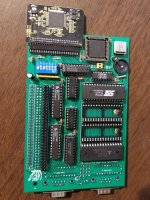bladamson
Veteran Member
I think the DMA controller on the older Tandies was just a convenient way to do dram refresh since the video circuit couldn't do it on the expansion ram. The fact that is enabled DMA with expansion cards was just kind of an extra feature. I don't think it's really needed on that class of machine. I mean, the main reason to have it would be to make an 8-bit SoundBlaster work, but I don't think anything that will run on that class of machine will support more than AdLib anyway for the most part.

